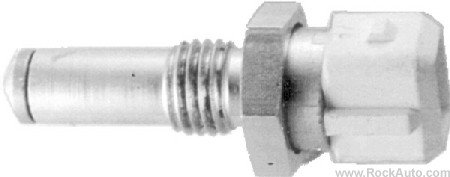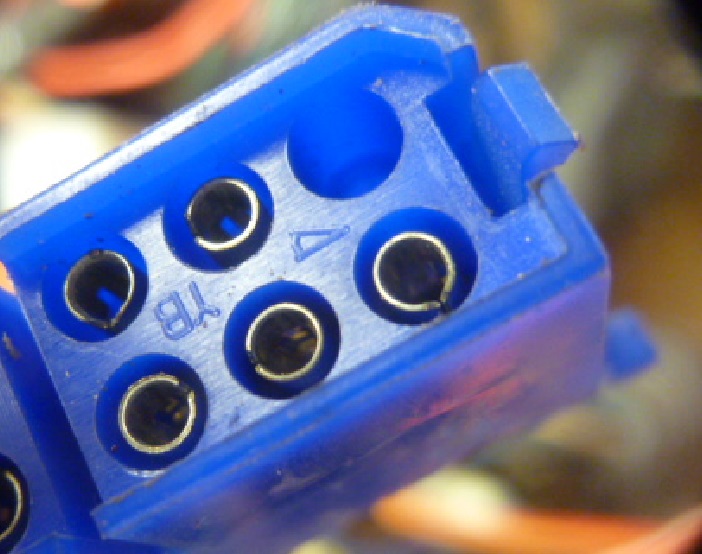Everything posted by Captain Obvious
-
Putting in a replacement L-28
I think the reason they did the spinny nut on the ZX version is for better thermal conductivity between the head casting and the sensor tip. I think sensor tip is designed to bottom out in the dry hole against the aluminum of the head. And they did that spinny nut thing so you weren't scraping the sensor tip as you tightened the nut. You could hold the sensor from rotating while you tightened the nut. Of course, that would also make it such that the spinny nut would not necessarily bottom out against any sort of sealing washer. I wonder of they used an O-ring seal there instead of a brass crush washer. I've got some ZX stuff around here someplace and if I can find it, I'll take a look. In any event... If you filled the hole with thermal conductive goop it would probably be fine. I can't believe the head temp changes that fast and I can't believe there would be a huge thermal gradient between the head and the sensor regardless if it bottomed out or not. But I wasn't there when they designed it.
-
1977 280z EFI Nightmare
Awesome! Glad you got to the root of the issue! You said "They wondered if it was the injectors so they did full spray tests into graduated cylinders for fuel flow, consistency, and volume, and it looked totally fine." Did they run that injector flow test on the car, or on the bench? I'm wondering if they used the 's ECU to drive the injectors, or a stand-alone injector tester rig designed to check things like that.
-
Putting in a replacement L-28
I just nabbed a pic off rockauto that shows the original ZX version with the spinning body: That said... The part above was the only one that looked like that. Most (all?) of the other aftermarket stuff looked like it did NOT have the spinning nut and could be used in either a wet or dry hole.
-
Putting in a replacement L-28
I don't know about the aftermarket stuff, but the original OEM ZX sensors are a little different in the way they mount... On the Z version, the brass body portion is all one piece and the electrical guts are crimped to the body to finish the assembly. In contrast, on the ZX version, the tightening nut spins independent of the sensor body. The "body" portion is two distinct and separate pieces. Why does that matter? Because if you use a ZX version with the spinning nut in a wet location like the Z thermostat housing, it will probably leak through the seam between the body and the nut. You could probably use a Z version in the side hole in a P79 or P90 head, but I would be wary of the converse of using a ZX version in a Z thermostat housing. That pic above of the aftermarket ZX sensor looks like it's made pretty much the same as the Z version, so who knows? Oh, and the connector key is in different locations between the two of them. Not an insurmountable issue, but something to be aware of.
-
Putting in a replacement L-28
I believe the straight threads are just normal metric pitch stuff. The tapered stuff is BSPT, but I think the straight threads are typical metric.
-
Preventing rust in the Z's lower front fenders
Dug up a pic courtesy of @jfa.series1
-
Preventing rust in the Z's lower front fenders
Where do the cowl drains dump out? Do they terminate in the area the you're trying to keep dry?
-
Fuel Line Blockage - New Cleaning method
That's very cool. Great thinking and adapting!!!
-
New owner and already she's a keeper!
LOL! So no bonus points, but it sounds like you don't need them. Beautiful car!
-
New owner and already she's a keeper!
Exactly. Sometimes a cigar is just a cigar.
-
Cool Tool of the Day. (CTOD)
Oh, and by the way... Great minds think alike! Here's some pics of mine I made who knows how many years ago. I used a cheap-o 12-point though because I figured that since I was going to be clamping the crap out of it with vice grips anyway, I opted for the maneuverability instead of the strength: Battle scars on the outside from all the vice-grips:
-
New owner and already she's a keeper!
Nice car! Bonus points* if you're still running the flat top carbs. * Not that it means squat, but it sounds impotent.
-
Connector specifications
Most of my hands on experience is with the later years (280's), and on those, pretty much all the connector stuff on the Z's was made by Yazaki. Logo is sorta an arrowhead and it looks like this: Some of the fuel injection stuff used on the 280's is AMP. But other than that, it's probably Yazaki.
-
Cool Tool of the Day. (CTOD)
Hahaha!!!! I also rotated the pic so I could get a better view of the number.....
-
Cool Tool of the Day. (CTOD)
So nobody wonders why I said that? Nobody is even going to ask? What? Am I the only person out there in the whole world that looked up the part number stamped on the handle on Jim's awesome transmission spinner device? Just me?
-
Cool Tool of the Day. (CTOD)
Well actually, according to Bob Bitchinn, the answer is "two". Apparently he rolls big joints.
- battery drain
-
Putting in a replacement L-28
I can't wait! You know it's not going to run first try, right? You know that, right? I'm no expert on such things, but here's what I would do. 0) Make sure you have a fire extinguisher and a spotter/helper with you. 1) disable the fuel injection system and pull the spark plugs. Crank it over a bunch like that first. Just to get the oil circulating and listen for grossly incorrect noises, etc. To disable the FI system, I would disconnect the fusible link that runs to the positive battery post. And to look for oil pressure, you should be able to pull the oil cap on the valve cover and watch for oil coming out of the holes in the camshaft lobes as you (your helper/spotter) crank the engine. 2) Once you've got oil flowing, put a timing light on it and you might be able to get it spinning fast enough on the starter to get your ignition timing somewhat close to target. 3) Then once you've got oil flowing (and maybe timing close), pull the starter solenoid wire off and just hang on the key for a little bit and listen to the fuel pump running. I can hear the difference in sound of the pump when the load changes on a full pressurized rail. 4) Then once you've got oil, spark timing, and fuel... Put the plugs in, reconnect the starter solenoid wire on, reconnect the FI fusible link, cross your fingers... And give it a go. And call me so I can hear it running in the background!!!
-
Cool Tool of the Day. (CTOD)
LOL. I like it!! That's a great idea. So what is it that opens your garage door now though?
-
Trouble shooting 1973 240z Ammeter/Fuel gauge
Cool. Things are better when the numbers line up. So it sounds like the needle heater can deal with 240mA on a pulse width modulated basis, but not forever. It's all about heat and average power.
-
Trouble shooting 1973 240z Ammeter/Fuel gauge
Well that's what I get for relying on memory... I just took a quick look at a fuel gauge, and I got the heater resistances wrong. The heaters (both regulator and needle movement) resistances are about 50 Ohms each, not the 100 Ohms I mentioned above. The SENDER unit is 90-100 when empty, but the heaters in the gauge are about half that. If the regulator is closed, it will pull about 240mA. And if the fuel sender is at zero (full scale), the needle heater will pull another 240mA. So if you run the gauge without the regulator heater (no ground connected), the needle heater will see a constant 240mA at 100% duty cycle (not the 130 I mentioned above).
-
Trouble shooting 1973 240z Ammeter/Fuel gauge
The gauge current will actually drop completely to zero when the regulator opens. You're looking at a wildly swinging PWM signal with the digital current meter on your power supply and I didn't see a zero fly by on the gauge, but it does actually cut off completely. And that comes back to the burn out the gauge question... In normal operation, the sender resistance could be zero. So in normal operation, the gauge heater will pass current proportional to it's heater resistance which is about 50 Ohms (which I believe is about 90-100 Ohms). But it doesn't pass that current 100% of the time. It's pulse width modulated and the average power is cut down because of that*. When you operate it without the regulator ground connected, it's running 240mA 130mA at a 100% duty cycle. And it sounds like given enough time, that's enough power to eventually heat up the nichrome wire to the point that it doesn't like it. *I didn't write anything down, but memory says the regulator runs at about 50% duty cycle once it's warmed up.
-
Trouble shooting 1973 240z Ammeter/Fuel gauge
Glad to help. That temperature compensator/regulator is really an ingenious little detail. I should really put together that "how the gauges really work" thread I suggested some time ago. In fact, I suspect the OP's issue with his gauge is dirty contacts in the regulator portion of his fuel gauge. (But I haven't officially suggested that yet because it's jumping the gun until you work through the other possibilities.) So, you had previously mentioned (in another thread) the caution about damaging the gauge if you didn't connect the ground. That ground connection is the low side of the regulator heater, so if it's disconnected the PWM will run full bore 100% to the sender unit. But I'm surprised to hear it's enough power to burn out the sender heater. You've seen this happen? It's only about 240mA 130mA.
-
Trouble shooting 1973 240z Ammeter/Fuel gauge
There will be some DC current draw variation due to the change in resistance of the sender unit, but the approx. once-per-second fluctuations in the current draw while you aren't changing the (simulated) sender resistance, that's not due to any divider. That's the temp/voltage regulator built into the switch. You're seeing the PWM draw from the regulator contacts opening and closing. You won't see this when you first hook up the gauge because the regulator is cold. And a cold regulator will run full bore (100% duty cycle) until it heats up.
-
Resolved: Tail Lights Stuck On
My brake switch bumper turned to dust a couple years ago. Looked like this: So, I chucked up a piece of metal on the lathe and made this: Glued the little rubber pad into the recess and put it up under the dash. A completely unreasonable and unprofitable amount of time later, I have this: Next time, I'll use a quarter. With maybe a couple layers of hockey stick tape over it to prevent any metal-to-metal noises.










